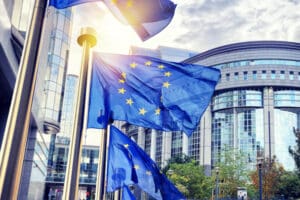
Is EU VAT Compliance Actually Improving?
5 min readBy:According to the latest “VAT Gap” report published by the European Commission (EC), value-added taxA tax is a mandatory payment or charge collected by local, state, and national governments from individuals or businesses to cover the costs of general government services, goods, and activities. (VAT) compliance increased in 2021. The VAT compliance gap—the additional VAT revenue that could be collected if all taxpayers, consumers, and businesses fully complied with VAT rules—dropped from 9.7 percent in 2020 (€99 billion) to 5.4 percent in 2021 (€61 billion).
However, this trend might change in the following years.
In 2021, the largest compliance gaps were observed in Romania (36.7 percent), Malta (25.7 percent), Greece (17.8 percent), and Lithuania (14.5 percent). The smallest compliance gaps were registered in the Netherlands, Finland, Spain (all below 1 percent), and Estonia (1.4 percent).
EU VAT Compliance Gaps at Historically Low Levels
| 2021 VAT Compliance Gap (%) | Percentage Change in VAT Compliance Gap from 2020 | |
|---|---|---|
| Romania | 36.70% | -0.50% |
| Malta | 25.70% | -1.80% |
| Greece | 17.80% | -3.20% |
| Lithuania | 14.50% | -4.20% |
| Italy | 10.80% | -10.70% |
| Slovakia | 10.60% | -3.40% |
| Cyprus | 8.30% | -9.20% |
| Latvia | 7.30% | -1.60% |
| Czech Republic | 7.00% | -5.10% |
| Belgium | 6.90% | -6.70% |
| Ireland | 6.70% | -6.00% |
| Croatia | 5.70% | -0.10% |
| Denmark | 5.00% | 0.70% |
| Bulgaria | 4.90% | -2.30% |
| France | 4.90% | -3.50% |
| Hungary | 4.40% | -2.70% |
| Sweden | 3.80% | 0.20% |
| Portugal | 3.60% | -3.40% |
| Poland | 3.30% | -7.80% |
| Austria | 2.80% | -3.80% |
| Germany | 2.80% | -2.80% |
| Slovenia | 2.00% | -3.40% |
| Luxembourg | 1.60% | -3.50% |
| Estonia | 1.40% | -3.60% |
| Spain | 0.80% | -4.70% |
| Finland | 0.40% | -1.90% |
| Netherlands | -0.20% | -4.20% |
| EU-27 | 5.40% | -4.30% |
The VAT compliance gap decreased in all EU countries except for Denmark (0.7%) and Sweden (0.2%). To understand this reduction, a more thorough analysis of the VAT compliance gap is needed.
The VAT compliance gap is caused not only by VAT avoidance or gaps in enforcement but also by unpaid VAT due to bankruptcies, insolvencies, or legal tax optimization.
Using Eurostat data on bankruptcies, we found a positive but low correlation of 0.3 between the decrease in the number of bankruptcies and the increase in VAT compliance. Nevertheless, in four countries, Bulgaria, Italy, Luxembourg, and Spain, where VAT compliance increased, an increase in bankruptcies was also observed. Therefore, for these four countries, other underlying aspects need to be checked as bankruptcies alone cannot explain these results.
According to the Commission’s report, the overall increase in compliance was due to the digitalization of the tax system and e-invoicing. The report also mentions that the “government support measures implemented during the COVID-19 pandemic, which were often contingent on paying taxes, may also have played a role in driving this positive change.”
While this could be a plausible explanation, the support measures might have increased compliance through an additional mechanism. The support measures implemented during the COVID-19 crisis also kept companies operating, reducing the number of bankruptcies and therefore increasing VAT compliance. And in fact, between 2020 and 2021, the number of bankruptcies dropped in most EU countries.
Additionally, in 2020, all EU countries implemented tax relief measures to support their economies during the pandemic. Except for Romania, countries postponed VAT tax payments or offered payment deferrals with no interest charges. Although these measures were temporary, in many countries 2020 VAT payments might have been pushed into the 2021 fiscal year. While Austria extended tax payment deferrals with no interest charges or penalties until 31 March 2021, Sweden delayed VAT payments for 12 months. In Belgium, the VAT due for the last period of the year 2020 could be paid in full before 20 January 2021, with no penalties. This postponement would have artificially increased VAT tax collection in 2021, while having no impact on the VAT tax liability, explaining the increase in VAT compliance in 2021.
Between 2019 and 2020 VAT compliance decreased sharply in Ireland and Cyprus but increased sharply in 2021. This supports the idea that 2020 VAT payments were deferred to 2021, leading to a sharp increase in VAT compliance in 2021 in both countries. This might also explain why VAT compliance increased in Bulgaria, Italy, Luxembourg, and Spain while the number of bankruptcies also increased.
Nevertheless, in the following years, this trend might be interrupted. The report estimates for 2022 show that the VAT compliance gap in absolute terms is expected to increase in 13 of the 19 countries for which estimates were available. Additionally, 2022 bankruptcy data already published by Eurostat portrays a gloomy perspective on businesses operating in the EU, as bankruptcies increased in 11 EU countries between 2021 and 2022. The biggest increases in bankruptcies were observed in Hungary (85 percent) France (52 percent), Belgium (42 percent), Lithuania (41 percent), and Spain (38 percent).
While the European Commission focuses on improving VAT compliance, policy is a major contributor to VAT revenue losses. The VAT actionable policy gap—the additional VAT revenue that could realistically be collected by eliminating reduced rates and certain exemptions—is 15.65 percent, more than triple the compliance gap.
Actionable VAT Policy Gap Split into the Rate Gap and the Actionable Exemption Gap in EU Countries, 2021
| Rate Gap (%) | Actionable Exemption Gap (%) | Actionable Policy Gap (%) | |
|---|---|---|---|
| Belgium | 12.00% | 3.60% | 15.60% |
| Bulgaria | 3.50% | 1.30% | 4.80% |
| Czech Republic | 7.10% | 5.90% | 12.90% |
| Denmark | 0.70% | 2.60% | 3.30% |
| Germany | 7.30% | 7.10% | 14.40% |
| Estonia | 2.50% | 7.80% | 10.30% |
| Ireland | 15.80% | -0.20% | 15.60% |
| Greece | 15.20% | 11.50% | 26.70% |
| Spain | 14.90% | 11.70% | 26.70% |
| France | 11.80% | 6.00% | 17.80% |
| Croatia | 11.30% | 3.90% | 15.20% |
| Italy | 14.40% | 10.90% | 25.30% |
| Cyprus | 18.00% | 2.70% | 20.70% |
| Latvia | 3.40% | 10.80% | 14.20% |
| Lithuania | 3.50% | 6.70% | 10.20% |
| Luxembourg | 17.70% | 3.00% | 20.70% |
| Hungary | 7.70% | 9.30% | 17.00% |
| Malta | 15.10% | -15.30% | -0.10% |
| Netherlands | 8.60% | 2.20% | 10.80% |
| Austria | 18.30% | -0.20% | 18.10% |
| Poland | 15.40% | 10.70% | 26.10% |
| Portugal | 13.90% | 5.60% | 19.60% |
| Romania | 11.80% | 6.80% | 18.60% |
| Slovenia | 10.60% | 8.90% | 19.60% |
| Slovakia | 3.20% | 10.40% | 13.70% |
| Finland | 9.20% | 4.70% | 13.90% |
| Sweden | 7.50% | 3.40% | 10.90% |
| EU-27 | 10.39% | 5.26% | 15.65% |
The VAT policy gap is made up of two components: the rate gap and the exemption gap. The former represents the loss in VAT revenue due to reduced VAT rates, and the latter is due to certain goods and services being exempt from the VAT.
However, there are some services—namely, imputed rents, the provision of public goods, and financial services—that are VAT-exempt because it would be difficult to levy a VAT on them. Subtracting the amount of lost VAT revenue caused by these services from the general Policy Gap leaves us with the actionable policy gap (i.e., the actionable exemption gap plus the rate gap), which is the amount of additional VAT revenue lawmakers could realistically raise by eliminating reduced rates and certain exemptions.
In 2021, the average actionable policy gap for the EU was 15.65 percent—of which 10.39 percent was due to reduced rates (rate gap) and 5.26 percent to the actionable portion of the exemption gap.
The rate gap is smaller in countries that rely on reduced rates less, such as Denmark (0.7 percent), Estonia (2.5 percent), Slovakia (3.2 percent), Latvia (3.4 percent) and Bulgaria (3.5 percent). On the other hand, the rate gap in Austria (18.3 percent), Cyprus (18 percent), Luxembourg (17.7 percent), Ireland (15.8 percent), Poland (15.4 percent), Greece (15.3 percent), and Malta (15.2 percent) show significant revenue forgone because of reduced rates. The highest actionable exemption gaps are observed in Spain (11.7 percent), Greece (11.5 percent), Italy (10.9 percent), Latvia (10.8 percent), Poland (10.7 percent), and Slovakia (10.4 percent). Spain’s actionable exemption gap is due to the application of different indirect taxes in the Canary Islands, Ceuta, and Melilla.
The highest actionable policy gaps are observed in Spain and Greece (both at 26.7 percent), Poland (26.1), Italy (25.3 percent), and Cyprus and Luxembourg (both at 20.7 percent). The actionable policy gap is smaller in Denmark (3.3 percent) and Bulgaria (4.8 percent).
Between 2020 and 2021, the VAT policy gap decreased from 16.43 percent to 15.65 percent. The average actionable policy gap for the EU decreased by 0.78 percentage points while the average rate gap increased by 0.49 percentage points. However, this trend will likely change in 2022 and 2023, as most EU countries introduced temporary rate reductions to value-added taxes on energy and food products as a price support measure to cushion the impact of a sharp rise in energy prices and inflationInflation is when the general price of goods and services increases across the economy, reducing the purchasing power of a currency and the value of certain assets. The same paycheck covers less goods, services, and bills. It is sometimes referred to as a “hidden tax,” as it leaves taxpayers less well-off due to higher costs and “bracket creep,” while increasing the government’s spending power. . These narrowing VAT tax baseThe tax base is the total amount of income, property, assets, consumption, transactions, or other economic activity subject to taxation by a tax authority. A narrow tax base is non-neutral and inefficient. A broad tax base reduces tax administration costs and allows more revenue to be raised at lower rates. measures would most likely increase the VAT actionable policy gap in 2022 and 2023.
While both compliance and policy gaps are expected to increase in the following years, policymakers will need to invest in reforming VAT systems to close gaps in ways that improve the overall efficiency of their tax systems.
Share this article




